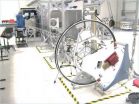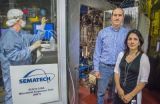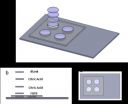(Press-News.org) The Magnetometer instrument that will fly on NOAA's GOES-R satellite when it is launched in early 2016 has completed the development and testing phase and is ready to be integrated with the spacecraft.
The Magnetometer will monitor magnetic field variations around the Earth and enable forecasters at NOAA's Space Weather Prediction Center to better predict the consequences of geomagnetic storms. These storms pose a threat to orbiting spacecraft and human spaceflight. In addition, the measurements taken by the Magnetometer will aid in providing alerts and warnings to power companies and satellite operators due to the potential damage a change in magnetic flux can have on electric power grids and satellite systems.
"This milestone is another example of our continuing progress to develop, build and launch GOES-R," said Greg Mandt, NOAA system program director for the GOES-R Series Program at NASA's Goddard Space Flight Center in Greenbelt, Maryland.
The Magnetometer instrument hosts a boom that, once in space, will extend 26 feet away from the satellite. This allows the sensor to be much more perceptive of the space magnetic environment, resulting in even better forecasting of space weather. The magnetometer sensors and electronics elements were built by Macintyre Electronic Design Associates, Inc. (MEDA) in Sterling, Virginia and the boom element of the instrument was built by ATK in Goleta, California. The electronics units were installed on the spacecraft panels and the sensors and the boom will be integrated onto the satellite in the fall. The Magnetometer is the fifth of six total instruments to be completed for the GOES-R satellite.
The advanced spacecraft and instrument technology on the GOES-R, or Geostationary Operational Environmental Satellite – R, series will result in more timely and accurate weather forecasts. It will improve support for the detection and observations of meteorological phenomena and directly affect public safety, protection of property and, ultimately, economic health and development.
The GOES-R series will be more advanced than the current GOES fleet. The satellites are expected to more than double the clarity of today's GOES imagery and provide more atmospheric observations than current capabilities with more frequent images.
INFORMATION:
NOAA manages the GOES-R Series Program through an integrated NOAA-NASA program office, located at NASA's Goddard Space Flight Center in Greenbelt, Md.
NOAA's mission is to understand and predict changes in Earth's environment, from the depths of the ocean to the surface of the sun, and to conserve and manage our coastal and marine resources.
Want to learn more about how space weather impacts life on Earth?
Visit NOAA Satellites on YouTube at: https://www.youtube.com/watch?v=hPiy4x5z0GI.
For more information about GOES-R, visit:
http://www.goes-r.gov or
http://www.nasa.gov/content/goes-r/
NOAA's GOES-R satellite Magnetometer ready for spacecraft integration
2014-07-15
ELSE PRESS RELEASES FROM THIS DATE:
For bees and flowers, tongue size matters
2014-07-15
For bees and the flowers they pollinate, a compatible tongue length is essential to a successful relationship. Some bees and plants are very closely matched, with bee tongue sized to the flower depth. Other bee species are generalists, flitting among flower species to drink nectar and collect pollen from a diverse variety of plants. Data on tongue lengths can help ecologists understand and predict the behavior, resilience and invasiveness of bee populations.
But bee tongues are hard to measure. The scarcity of reliable lingual datasets has held back research, so Ignasi ...
Study finds why some firms are 'named and shamed' by activists
2014-07-15
COLUMBUS, Ohio – A new study of the anti-sweatshop campaigns of the 1990s reveals which companies are most likely to become targets of anti-corporate activists.
Researchers found that companies tended to attract the attention of labor activists if they were large, had prominent brand images, or had good corporate reputations. When combined, these factors were especially important.
"Companies that had all of these characteristics were nearly guaranteed to be a target of activism," said Tim Bartley, lead author of the study and associate professor of sociology at The ...
Fundamental chemistry findings could help extend Moore's Law
2014-07-15
Over the years, computer chips have gotten smaller thanks to advances in materials science and manufacturing technologies. This march of progress, the doubling of transistors on a microprocessor roughly every two years, is called Moore's Law. But there's one component of the chip-making process in need of an overhaul if Moore's law is to continue: the chemical mixture called photoresist. Similar to film used in photography, photoresist, also just called resist, is used to lay down the patterns of ever-shrinking lines and features on a chip.
Now, in a bid to continue decreasing ...
Study: Body Dysmorphic Disorder patients have higher risk of personal and appearance-based rejection sensitivity
2014-07-15
PROVIDENCE, R.I. – In a recent study, researchers at Rhode Island Hospital found that fear of being rejected because of one's appearance, as well as rejection sensitivity to general interpersonal situations, were significantly elevated in individuals with Body Dysmorphic Disorder (BDD). These fears, referred to as personal rejection sensitivity and appearance-based rejection sensitivity, can lead to diminished quality of life and poorer mental and overall health. BDD is a common, often severe, and under-recognized body image disorder that affects an estimated 1.7 to 2.4 ...
Prostate cancer in young men -- More frequent and more aggressive?
2014-07-15
ANN ARBOR, Mich. -- The number of younger men diagnosed with prostate cancer has increased nearly 6-fold in the last 20 years, and the disease is more likely to be aggressive in these younger men, according to a new analysis from researchers at the University of Michigan Comprehensive Cancer Center.
Typically, prostate cancer occurs more frequently as men age into their 70s or 80s. Many prostate cancers are slow-growing and many older men diagnosed with early stage prostate cancer will end up dying from causes other than prostate cancer.
But, the researchers found, ...
Rollout strategy for diagnostic test in India may impact TB
2014-07-15
Xpert MTB/RIF, a recently implemented tuberculosis (TB) test, has the potential to control the TB epidemic in India, but only if the current, narrow, implementation strategy is replaced by a more ambitious one that is better funded, also includes the private sector, and better referral networks are developed between public and private sectors, according to new research published in this week's PLOS Medicine. The study by David Dowdy, from Johns Hopkins University, United States, and colleagues is a mathematical model that suggests alternative strategies that include engagement ...
Molecular 'eat now' signal makes cells devour dying neighbors
2014-07-15
A team of researchers has devised a Pac-Man-style power pellet that gets normally mild-mannered cells to gobble up their undesirable neighbors. The development may point the way to therapies that enlist patients' own cells to better fend off infection and even cancer, the researchers say.
A description of the work will be published July 15 in the journal Science Signaling.
"Our goal is to build artificial cells programmed to eat up dangerous junk in the body, which could be anything from bacteria to the amyloid-beta plaques that cause Alzheimer's to the body's own ...
Neurons, brain cancer cells require the same little-known protein for long-term survival
2014-07-15
CHAPEL HILL, N.C. – Researchers at the UNC School of Medicine have discovered that the protein PARC/CUL9 helps neurons and brain cancer cells override the biochemical mechanisms that lead to cell death in most other cells. In neurons, long-term survival allows for proper brain function as we age. In brain cancer cells, though, long-term survival contributes to tumor growth and the spread of the disease.
These results, published in the journal Science Signaling, not only identify a previously unknown mechanism used by neurons for their much-needed survival, but show that ...
Rollout strategy is key to battling India's TB epidemic, researchers find
2014-07-15
A new study led by Johns Hopkins Bloomberg School of Public Health researchers suggests that getting patients in India quickly evaluated by the right doctors can be just as effective at curbing tuberculosis (TB) as a new, highly accurate screening test.
While ideally all suspected TB cases would be evaluated with the new test, it is primarily being used only on the highest-risk populations and only in public health clinics, partly because of its cost and the complexity of the nation's health care system. This slows diagnosis of a disease that must be caught early, the ...
New assay to spot fake malaria drugs could save thousands of lives
2014-07-15
CORVALLIS, Ore. – Chemists and students in science and engineering at Oregon State University have created a new type of chemical test, or assay, that's inexpensive, simple, and can tell whether or not one of the primary drugs being used to treat malaria is genuine – an enormous and deadly problem in the developing world.
The World Health Organization has estimated that about 200,000 lives a year may be lost due to the use of counterfeit anti-malarial drugs. When commercialized, the new OSU technology may be able to help address that problem by testing drugs for efficacy ...





